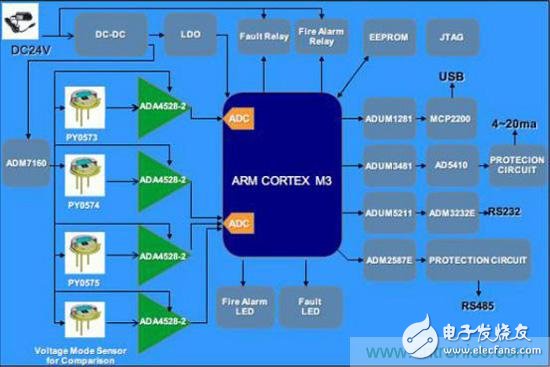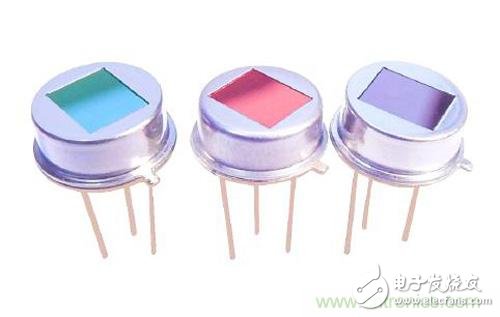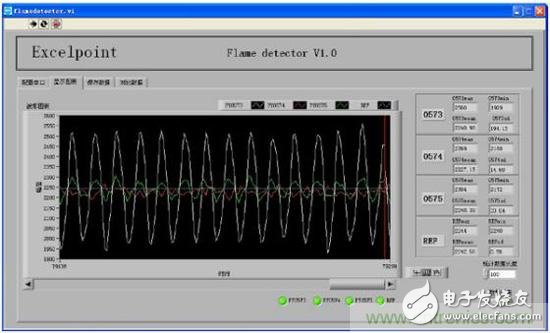Regardless of the design, security is always "just needed." For construction projects, fire protection is an essential factor to consider. Smoke alarms are the most commonly used means in general civil and commercial buildings. However, in some special industrial places, such as industrial plants, warehouses, tunnels, etc., the spatial scale is large and requires a faster fire alarm response speed, which requires a more sensitive photosensitive flame detector.
The principle of this type of flame detector is to detect the ultraviolet rays and infrared rays with special wavelengths in the flame at the beginning of the fire through special sensors, and trigger the alarm as much as possible in the "emergence period" of the fire to protect the safety of the project.
Photosensitive flame detectors are mainly divided into two categories: ultraviolet and infrared, each of which has its own characteristics. Traditionally, the ultraviolet flame detection response is fast, but the distance of action is slightly closer than that of infrared. Because it is sensitive to ultraviolet light, it is not suitable for outdoor detection. The infrared action distance is long, but the response speed is slow, and it can be used indoors and outdoors. With the advancement of technology, such a boundary has gradually become blurred. For example, the infrared flame detection reference scheme designed by Shijian International Trading (Shanghai) Co., Ltd., which we dismantled today, is fast, long-distance, and high-sensitivity. The performance is all in one, it makes people look impressive.

Figure 1: World Health Infrared Flame Detection Reference Scheme Block Diagram
In this scheme, the flame signal is converted into a voltage signal by a thin film pyroelectric infrared sensor, and is filtered by an op amp bandpass, and then an MCU on-chip ADC performs data acquisition.
The primary factor in determining the performance of an infrared flame detection system is the infrared sensor. The solution uses Pyreos' thin-film pyroelectric infrared flame sensors, which provide a response speed of 12mS, a typical field of view of up to 100°, and an excellent signal-to-noise ratio in flames of 8-10 Hz. The sensor also has a built-in CMOS op amp, which further enhances the stability and reliability of the detection. Xavier Xiong, senior manager of the technical support department of Shijian Company, who is in charge of the program, said that the distance between the sensor and the customer's characteristic algorithm can reach 65 meters, which is far beyond the requirements of the national standard for 25 meters and 19 meters. .
Unlike the current mainstream voltage-type infrared flame detection sensors in the country, Pyroos's series of sensors use current mode, which is the key to its performance to break the "limit" - the average voltage mode of the infrared sensor's limit detection distance is within 60 meters, and The response speed is above 120mS.
Shijian's infrared flame detection scheme uses a triple infrared (IR3) architecture. The three infrared detectors in the system perform their duties: PY0573 for flame detection, and PY0574 and PY0575 for identifying external infrared sources such as human body and sunlight. Interference to prevent false positives.

Figure 2: Pyreos' thin-film pyroelectric infrared sensor has a response speed of 12mS and a detection range of up to 65 meters.
Of course, to ensure the overall performance of the solution and improve the measurement accuracy of the system, only the sensor is not enough. Shijian also made a lot of effort in the selection of supporting chips. From the BOM list of the solution, we can see that Shijian engineers specially selected ADI's ultra-low noise op amp ADA4528-2, ultra-low noise LDO ADM7160 and other peripheral components with excellent noise performance, so that the characteristics of the sensor are maximized. Played out.
As a reference design, the main control chip of this solution uses the popular ARM Cortex-M3 architecture, which makes it easy for developers to transplant their own algorithms and give developers more flexibility. At the same time, the rich support interfaces such as RS232 and RS485 are supported in the reference scheme to meet the needs of most application scenarios.
Through the supporting software, developers can observe the test and analysis data of different sensor channels in the solution. It can be used as the evaluation board of Pyreos's thin film pyroelectric infrared sensor, or directly as the reference design of the actual product. The ingenuity and sincerity of Shijian engineers can be seen.

Figure 3: Visualizing test and analysis data with software from the reference solution
Piezoelectric Rings For Ultrasonic Machining
Ultrasonic processing is a special processing tool that uses ultrasonic frequency to vibrate at small amplitudes, and through the impact of the abrasive free of liquid between it and the workpiece on the processed surface, the surface of the workpiece material is gradually broken.
Yuhai company is engaged in produce high performance piezoelectric elements,
Custom Hifu Piezo Parts,Hifu Ultrasonic Focusing Part,Piezo Crystal For Hifu,Cheap Hifu Transducer
Zibo Yuhai Electronic Ceramic Co., Ltd. , https://www.yhpiezo.com
